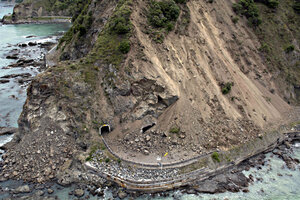New Zealand sea floor lifted by quake becomes cliff on a beach
New Zealand's newest beach feature is not likely to disappear any time soon, after the recent massive earthquake pushed a chunk of coast several feet up.

A landslide covers a section of State Highway 1 near Kaikoura after a magnitude 7.8 earthquake hit New Zealand this past week, buckling roads, uplifting sections of coastline, and killing two people, Monday, Nov. 14.
David Alexander/SNPA/AP
The 7.8 magnitude earthquake that shook New Zealanders this week stranded residents and tourists, destroyed their homes, and reshaped their world – literally.
After the dust had settled, some residents of the South Island realized that their beaches looked very different. The earthquake had been so powerful that it lifted the sea floor one to six feet above its previous position, leaving a massive cliff in the middle of the beach.
"The earthquake involved slip on at least four to six distinct faults, with the greatest slip occurring on the Kekerengu fault, which appears to have slipped about 10 meters along part of its length," USGS Earthquake Hazards Program associate coordinator Dr. Michael Blanpied explained to CNN.
"There also appears to have been vertical slip on a newly revealed fault in Waipapa Bay. The effect of these motions was to lift portions of the coast by one half to as much as two meters,” he said.
The pinkish seabed is an unusual sight for residents of the tourist town of Kaikoura. Now rising between one and six feet above the rest of the beach, the new sea wall is covered with seaweed and marine animals like crayfish and sea snails.
The South Island’s coastline is not the only thing affected by the earthquake. The nearby Kekerengu fault is a vertical fault, which means that many local roads now feature steep drop offs, or suffered landslides as a result of the earthquake.
It took less than three minutes for the earthquake to reshape the landscape, including creating the beach feature. It would have been an astounding sight if it had been light enough to witness the change.
"I’ve never seen it before during an earthquake, and it’s the first time we’ve seen something like this," New Zealand’s National Institute of Water and Atmospheric Research marine geologist Joshu Mountjoy told Stuff.
GNS Science, a New Zealand research institute, writes that it is unlikely that the coastline will return to normal in the future. The sea snails and other marine creatures that are currently stranded above the tides are most likely out of luck, researchers say.
According to GNS Science, coastal uplift can either occur after short, dramatic events like a huge earthquake or as a result of long, slow geological activity.
New Zealand is no stranger to tectonic changes. Earthquakes and volcanoes formed New Zealand’s famous mountains and shaped its landscape.
Researchers say that the earthquake will transform the marine life of the affected coast, as well as the coastline itself.
“There will be a major shift in the community of marine species. Many seaweeds and animals that would normally be permanently covered by water will now be struggling to exist in a zone of transition between air and sea,” GNS Science researchers wrote in their initial report. “As the animals not suited to this environment die from the reef, they will be replaced by seaweed and animals appropriate for the new tidal level.”

